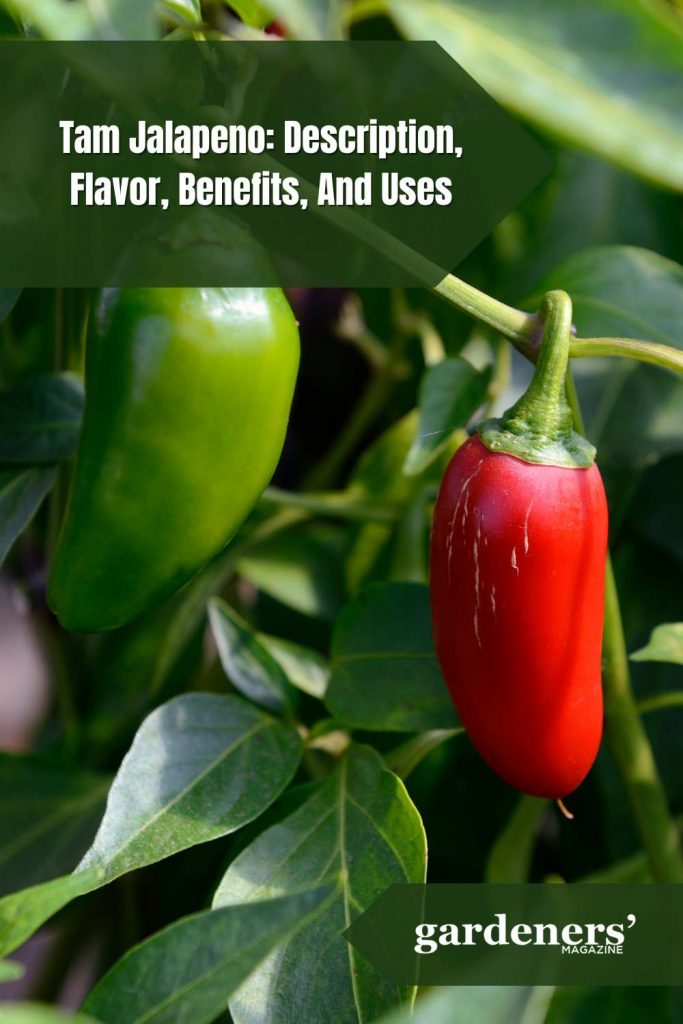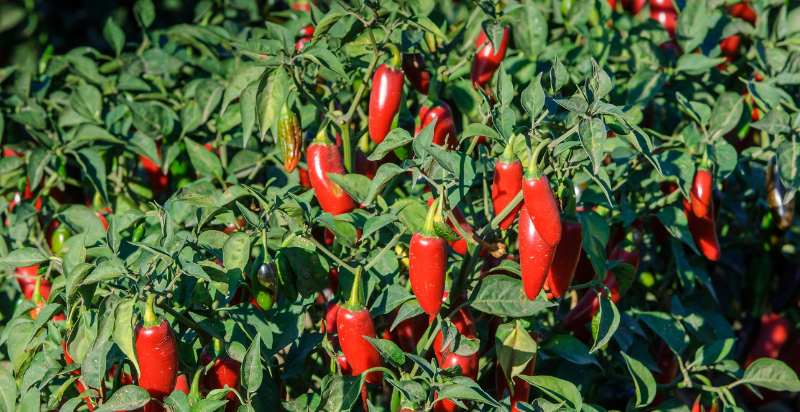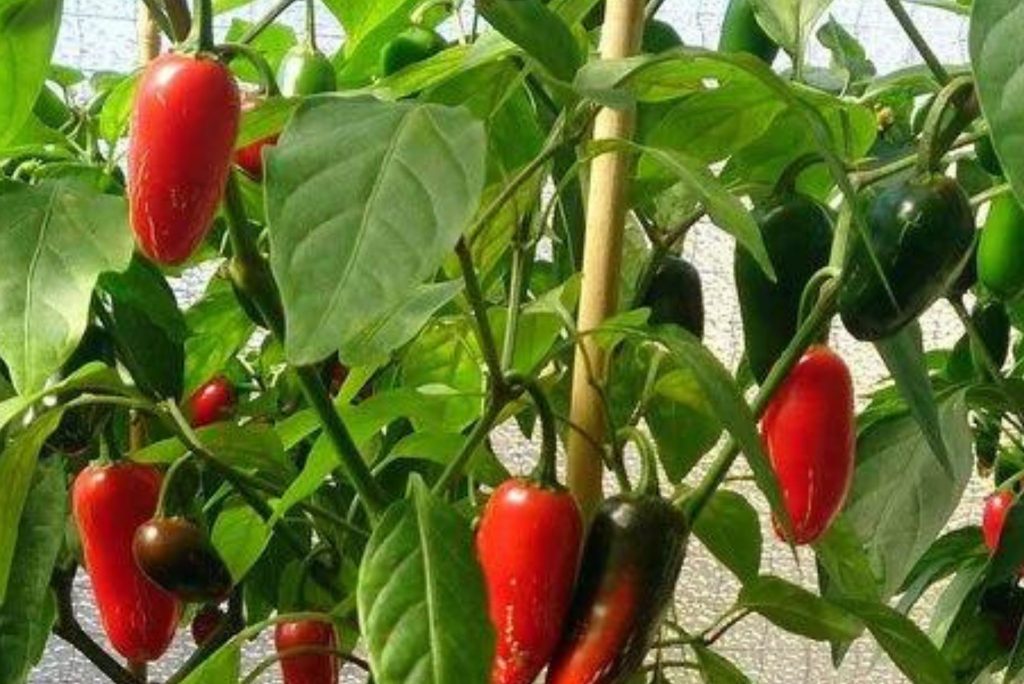The Tam Jalapeno pepper derives its name from its origins at the New Mexico State University’s Agricultural Experiment Station in Las Cruces, New Mexico. The “Tam” in Tam Jalapeno stands for “Texas A&M,” representing the collaboration between Texas A&M University and New Mexico State University in developing this particular jalapeno cultivar.
This hot pepper has become increasingly popular among gardeners and chefs alike because of its easy-to-grow characteristics, milder flavor than other hot peppers, and higher harvest productivity. This article will examine the Tam Jalapeno in depth, covering its history, growing tips, culinary uses, and health benefits.

What is a Tam Jalapeno?
As a gardener, let me introduce you to the Tam Jalapeno, a delightful pepper variety prized for its compact size, fiery heat, and robust flavor. Scientifically known as Capsicum annuum ‘Tam Jalapeno’, this cultivar offers all the spicy punch of traditional jalapenos in a more manageable package, making it perfect for smaller garden spaces or container gardening.
The Tam Jalapeno pepper typically grows to about 2-3 inches in length and ripens from green to red as it matures, adding visual interest to any garden. With its versatility in the kitchen, the Tam Jalapeno is a favorite among chili enthusiasts for adding a kick to salsas, sauces, and spicy dishes. Whether you’re a seasoned gardener or new to growing peppers, the Tam Jalapeno is a must-have addition to your garden that promises to spice up your culinary creations.
History and Origin of the Tam Jalapeno Pepper:
The Tam Jalapeno pepper was developed by a team of TAMU scientists in the early 1990s. After years of research, they created a hybrid jalapeno with a milder flavor and thicker walls than other varieties. The pepper has since become popular among home and commercial growers due to its adaptability to different climates and soils. Compared to other jalapenos, it is also renowned for producing great yields.
The variety was specifically bred to thrive in the Southwestern United States, particularly in the hot and arid climate of Texas and New Mexico. The “Jalapeno” part of its name comes from the fact that it is a type of jalapeno pepper known for its spicy flavor and culinary versatility. Therefore, the name “Tam Jalapeno” reflects both its breeding origins and its classification as a jalapeno pepper.
Over time, the Tam Jalapeno pepper has become a popular choice for gardeners and farmers in the Southwestern United States, valued for its compact size, fiery heat, and robust flavor. Its successful cultivation and widespread adoption speak to its adaptation to the region’s climate and its appeal to chili enthusiasts and culinary aficionados alike.
Growing Conditions of Jalapeno Pepper:
Jalapeno peppers, including the Tam Jalapeno variety, thrive in warm and sunny conditions, making them well-suited to regions with hot summers. Here are the optimal growing conditions for jalapeno peppers:
- Temperature: Jalapeno peppers prefer temperatures between 70°F and 90°F (21°C to 32°C) for optimal growth. They are sensitive to cold temperatures and should be planted after the last frost date in spring.
- Sunlight: Provide jalapeno peppers with full sunlight exposure, ideally at least 6 to 8 hours per day. Placing them in a sunny spot ensures robust growth and high fruit production.
- Soil: Plant jalapeno peppers in well-draining, fertile soil with a pH level between 6.0 and 7.0. Amending the soil with organic matter such as compost or aged manure helps improve soil structure and nutrient availability.
- Watering: Keep the soil consistently moist but not waterlogged. Water deeply when the top inch of soil feels dry, aiming to provide about 1 to 2 inches of water per week. Avoid overhead watering to prevent fungal diseases.
- Spacing: Space jalapeno pepper plants about 18 to 24 inches apart in rows spaced 24 to 36 inches apart. Providing adequate spacing allows for proper air circulation and prevents overcrowding.
- Support: While jalapeno pepper plants are generally compact, providing support such as stakes or cages can help prevent branches from bending or breaking under the weight of the fruit.
- Fertilization: Apply a balanced fertilizer or organic compost to the soil at planting time and again when the first fruits appear. Avoid over-fertilizing with nitrogen, as it can lead to excessive foliage growth at the expense of fruit production.
By providing the right growing conditions, gardeners can cultivate healthy and productive jalapeno pepper plants, including the Tam Jalapeno variety, and enjoy a bountiful harvest of spicy peppers.

Nutritional Benefits of Jalapeno Pepper:
Jalapeno peppers, including the Tam Jalapeno variety, offer a plethora of nutritional benefits. Rich in essential vitamins and minerals like vitamin C, vitamin A, vitamin K, and potassium, they support various bodily functions, including immune health, vision, and electrolyte balance.
Additionally, jalapenos contain capsaicin, the compound responsible for their spicy heat. This compound has been linked to potential health advantages such as pain relief, improved metabolism, and reduced inflammation. It also has anti-oxidant effect.
Furthermore, jalapenos provide antioxidants such as beta-carotene and vitamin C, which help protect cells from damage and may lower the risk of chronic diseases like cancer and heart disease. Their fiber content promotes digestive health by aiding in regular bowel movements, while potassium contributes to heart health by regulating blood pressure.
Overall, incorporating jalapeno peppers into your diet can add both flavor and vital nutrients, potentially enhancing overall health and well-being.
Where are Jalapeno Pepper Grown and Harvested?
Jalapeno peppers are grown and harvested in various regions around the world, but they are particularly well-suited to warm and sunny climates. Major jalapeno pepper-producing countries include Mexico, the United States, and China. In Mexico, jalapenos are a staple ingredient in many traditional dishes and are grown extensively in regions such as Veracruz, Oaxaca, and Sinaloa. In the United States, jalapenos are cultivated in states like Texas, California, New Mexico, and Florida, where the climate is conducive to their growth. Additionally, jalapenos are grown in other countries with suitable climates, including Spain, India, and Thailand.

What is the Flavor Profile of the Jalapeno Pepper?
The jalapeno pepper’s flavor profile is characterized by a unique combination of spicy heat, tanginess, and subtle sweetness. Jalapenos have a moderate to high level of spiciness, which can vary depending on factors such as growing conditions and ripeness.
They provide a noticeable kick without being overwhelmingly hot, making them versatile for a wide range of culinary applications. In addition to their spicy heat, jalapenos offer a slightly tangy and grassy flavor with hints of fruitiness reminiscent of green bell peppers. The Scoville Heat Units (SHU) value of jalapeno peppers typically ranges from 2,500 to 8,000 SHU.
Where can the Best Quality Jalapeno Peppers be Found?
The best quality jalapenos can be found at farmer’s markets or specialty grocery stores. Look for firm and glossy peppers with no signs of decay or discoloration. If possible, try to buy jalapeno peppers that are organic and locally sourced, as these will have the freshest taste. You can also grow your own jalapenos in a garden if you prefer.
What are Some Ways to Use Jalapeno Pepper?
Jalapeno peppers can be used in various dishes, including salsas, sauces, stews, soups, salads, and more. Here are some ways to do so :
- Create a fresh salsa of diced tomatoes, onion, cilantro, lime juice and diced jalapenos.
- Make a healthy and delicious jalapeno guacamole by mashing together avocado, diced jalapenos, cilantro, lime juice, garlic and salt.
- Stir fry vegetables such as bell peppers, celery and carrots with sliced jalapenos.
- Top pizzas or quesadillas with jalapenos to add a spicy twist.
- Create a zesty vinaigrette by blending olive oil, garlic, jalapeno peppers, and lime juice.
- Combine pureed jalapenos with fresh mango chunks for an exotic salsa.

What is the Best Way to Store Jalapenos?
To store jalapenos, refrigeration is key. Keep them in the fridge to maintain freshness. Ensure they’re dry before storing to prevent moisture buildup, which can lead to mold. Ventilation is crucial; opt for perforated plastic bags or breathable containers to allow air circulation. Store them in the crisper drawer, where the temperature is slightly higher and stable. Aim for around 45 to 50°F (7 to 10°C) for optimal storage conditions. Use fresh jalapenos within a week for the best flavor and texture. While they may last longer if stored properly, their flavor and heat may diminish over time.
Conclusion:
In conclusion, jalapenos are a flavorful and spicy addition to many dishes. Store them in the refrigerator in a partially sealed plastic bag or an airtight container. If you pickle your jalapenos, store them in an airtight jar and refrigerate for up to 6 months. Enjoy!
- Everything You Wanted to Know About Red Tamarillos - June 2, 2025
- A Guide to Tulips: Everything You Need to Know & More… - June 2, 2025
- Guanabana: Description, Flavor, Benefits, And Uses - May 27, 2025

8 thoughts on “Tam Jalapeno: Description, Flavor, Benefits, And Uses”
Comments are closed.